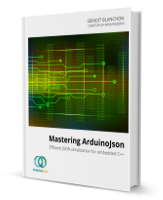JsonParserExample.ino
Description
This example shows how to deserialize a JSON document with ArduinoJson.
An online demo of this example is available on wandbox.org.
Source code
// ArduinoJson - arduinojson.org
// Copyright Benoit Blanchon 2014-2018
// MIT License
#include <ArduinoJson.h>
void setup() {
// Initialize serial port
Serial.begin(9600);
while (!Serial) continue;
// Memory pool for JSON object tree.
//
// Inside the brackets, 200 is the size of the pool in bytes.
// Don't forget to change this value to match your JSON document.
// Use arduinojson.org/assistant to compute the capacity.
StaticJsonBuffer<200> jsonBuffer;
// StaticJsonBuffer allocates memory on the stack, it can be
// replaced by DynamicJsonBuffer which allocates in the heap.
//
// DynamicJsonBuffer jsonBuffer(200);
// JSON input string.
//
// It's better to use a char[] as shown here.
// If you use a const char* or a String, ArduinoJson will
// have to make a copy of the input in the JsonBuffer.
char json[] =
"{\"sensor\":\"gps\",\"time\":1351824120,\"data\":[48.756080,2.302038]}";
// Root of the object tree.
//
// It's a reference to the JsonObject, the actual bytes are inside the
// JsonBuffer with all the other nodes of the object tree.
// Memory is freed when jsonBuffer goes out of scope.
JsonObject& root = jsonBuffer.parseObject(json);
// Test if parsing succeeds.
if (!root.success()) {
Serial.println("parseObject() failed");
return;
}
// Fetch values.
//
// Most of the time, you can rely on the implicit casts.
// In other case, you can do root["time"].as<long>();
const char* sensor = root["sensor"];
long time = root["time"];
double latitude = root["data"][0];
double longitude = root["data"][1];
// Print values.
Serial.println(sensor);
Serial.println(time);
Serial.println(latitude, 6);
Serial.println(longitude, 6);
}
void loop() {
// not used in this example
}
Classes used in this example
Functions used in this example
Keep learning
The chapter “Deserialize with ArduinoJson” of Mastering ArduinoJson is a tutorial on deserialization. Among other things, it shows how to parse the response from Yahoo Weather.
The chapter “Case Studies” dissects several projects that implement the best practices. For example, it shows how to write a program that recursively prints all the values in a JSON document.
